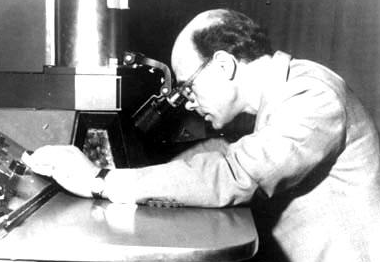![]() On April 25, Genome Biology published an interview with Raymond Gosling, who took the famous Photo 51 upon which Watson & Crick's model of DNA's double helix was based. Gosling had worked closely with Rosalind Franklin, whose contribution to the discovery is now rightly celebrated. However, he had initially been recruited to the project by John Randall, head of the MRC Biophysics Unit at King's College London, where the research took place.
On April 25, Genome Biology published an interview with Raymond Gosling, who took the famous Photo 51 upon which Watson & Crick's model of DNA's double helix was based. Gosling had worked closely with Rosalind Franklin, whose contribution to the discovery is now rightly celebrated. However, he had initially been recruited to the project by John Randall, head of the MRC Biophysics Unit at King's College London, where the research took place.
Gosling expressed his disappointment at the lack of recognition Randall has received for his role in the discovery, and emphasized that this omission was the most important message he wanted to convey to Genome Biology's readership.
After publishing the interview, Genome Biology was contacted by Stanley Bayley, who had also been a PhD student under Randall at the MRC Biophysics Unit, although a few years earlier than Gosling. He was very pleased to read of Gosling's appreciation for Randall, a viewpoint he shared. Reproduced below is a short text written by Bayley detailing his own memories of Randall and biophysics at King's College in the years preceding the double helix discovery.
Stanley Bayley's memoir

'After the hard time many commentators on the DNA work gave Randall, I was very glad to read Raymond Gosling's strong defense of his role in that work, and in his biophysics group generally. Randall always treated me very fairly, and I often thought I should write something about his better side, but had no idea where to send it. But with Gosling's background, his is a much better job than anything I could have managed.
The way I joined Randall's group was different from Gosling. I sat my Honors Physics finals at King's in 1945, and was then accepted as a postgraduate student in atomic physics in the Physics Department. My supervisor was a Reader just returned from working on the atom bomb in N. America. I soon found studying under him was not at all congenial, and was greatly relieved when a few months later he was arrested. He was Alan Nunn May, the first atomic spy.
When Randall arrived at King's in 1946, he accepted me as a student. I found him friendly, modest about his war-time work on the cavity magnetron, and never one to take undue advantage of his position as Wheatstone Professor. For my first research project, he suggested I look into the possibility of doing autoradiography on individual cells. After a few experiments, I decided that, with phosphorus 32 as the tracer and more sensitive X-ray film, it should be possible. He suggested I write the work up and submit it for publication under my own name. It was accepted and I had a letter to Nature at the age of 20! My career never progressed at that rate again though. Later on, I worked with him on a new British electron microscope. Again, our relationship was very amicable. After we came to Canada, he twice visited the NRC labs in Ottawa where I worked. This was after 1953, but I never questioned him about the DNA saga.'
Stanley T. Bayley
Professor emeritus,
McMaster University
Single cells
With recent advances in microfluidic, sequencing and microscopy technology, single cells are currently a hot topic in many fields of biology, not least genomics – as evidenced by several recent publications in Genome Biology, a special issue in Genome Medicine, and a dedicated day at Genome Biology's upcoming Beyond The Genome conference. So it's interesting to note that Bayley was publishing on single-cell analyses nearly 70 years ago, in 1947. In fact, by our reckoning, Bayley was the first researcher to publish a single-cell paper in Nature.
Spies
British academia has a somewhat unenviable connection with treason and espionage in favor of the Soviet Union. Bayley recalls Alan Nunn May, famously the first 'atomic' spy to be exposed – not only did May pass on atomic secrets to the USSR, he even went so far as to hand over actual samples of radioactive uranium.
That said, far more damaging was the disloyalty of Klaus Fuchs, a German-born British scientist who, unlike the peripheral Nunn May, was at the very heart of the Manhattan Project.
Alan Nunn May has a further connection with the double helix – he was an alumnus of the Cavendish Laboratory, where Crick and Watson made their discovery. As with Crick and Watson, Nunn May had been at the Cavendish during Sir Lawrence Bragg's tenure, providing an additional connection with Randall, who had begun his career as Bragg's PhD student.
The Cavendish Laboratory is of course affiliated with The University of Cambridge, indelibly linked with Soviet espionage through the infamous Cambridge spy ring, of which Kim Philby – perhaps the most important member due to his high office in MI6 – is a good candidate for the mole who tipped off Nunn May (or his handlers) that a rendezvous at the British Museum was compromised.
The archives show that Philby was fully informed of the investigation into Nunn May, and so it seems likely that he was aware of the intention to stakeout the meeting. Nunn May's no-show prevented the security services from penetrating deeper into the spy network.
Latest posts by Naomi Attar (see all)
- tRFs and the Argonautes: gene silencing from antiquity - 2nd October 2014
- Keeping up with the Jobses: the role of technology in reproducible research - 26th September 2014
- How to disarm a superbug – a story told by forensic genomics - 23rd June 2014
One Comment